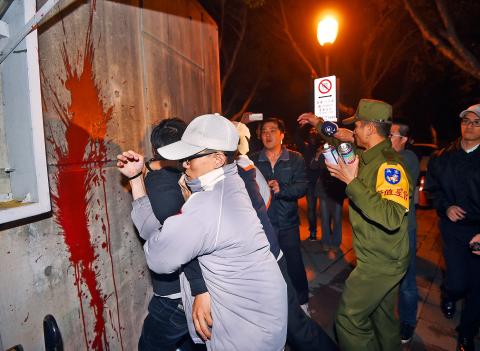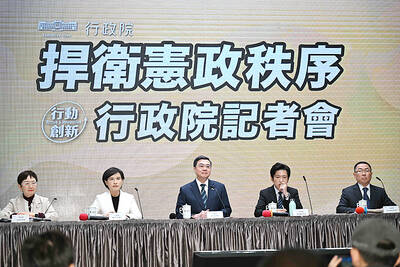Taiwan Solidarity Union (TSU) members in the early hours of yesterday staged a protest outside the presidential residence ahead of China’s scheduled inauguration of the controversial M503 flight route today.
Protesters shouted: “Withdraw the M503 flight route” and “President Ma Ying-jeou (馬英九), step down.”
Loud screams broke the quiet night near the presidential residence when several men and women holding protest signs arrived by van and motorcycle, and ran toward the entrance gate on Chongqing S Road in Taipei.

Photo: Fang Pin-chao, Taipei Times
Security guards were immediately alerted, with several plainclothes officers rushing to the site of the protest and quickly confronting the participants.
However, as officers tried to gain control of the situation in front of the gate, another group of protesters arrived at the northeastern corner of the presidential residence, spreading red paint on a wall.
More officers rushed from across the street, wielding metal shields and batons.
“We are here to demand that Ma decline to accept China’s inauguration of the M503 flight route, because it is a trap for Taiwan, and Ma is selling out Taiwan’s interests,” TSU Youth director Chang Chao-lin (張兆林) said as he was dragged away by security personnel.
“We call on all Taiwanese to stand up, we should all stand up in protest against Ma,” he added.
Besides clashes with the protesters, there were also minor verbal disputes between military police officers and journalists, as officers initially tried to prohibit journalists from taking pictures of the paint-splattered wall.
A total of 13 protesters were later taken to the nearby Zhongzheng Second Police Precinct Office for interrogation.
Deputy Precinct Chief Yu Tseng-hsiang (于增祥) said the protesters who threw red paint at the presidential residence would be charged with violating the Waste Disposal Act (廢棄物清理法).
Each was fined NT$6,000 for the waste disposal violations. Eight protesters also faced charges of interfering with public functions over the clash, a police officer said.
Presidential Office spokesman Charles Chen (陳以信) condemned the protest as an “act of violence.”
“The Republic of China is a democracy, and Taiwan is a society with the rule of law,” he said. “Any political appeal should be made based on the rule of law, and not surpass the boundary of being peaceful and rational.”
The protesters were released after questioning, and vowed to take further actions if the government does not respond positively to their demands.

The US government has signed defense cooperation agreements with Japan and the Philippines to boost the deterrence capabilities of countries in the first island chain, a report by the National Security Bureau (NSB) showed. The main countries on the first island chain include the two nations and Taiwan. The bureau is to present the report at a meeting of the legislature’s Foreign Affairs and National Defense Committee tomorrow. The US military has deployed Typhon missile systems to Japan’s Yamaguchi Prefecture and Zambales province in the Philippines during their joint military exercises. It has also installed NMESIS anti-ship systems in Japan’s Okinawa

‘WIN-WIN’: The Philippines, and central and eastern European countries are important potential drone cooperation partners, Minister of Foreign Affairs Lin Chia-lung said Minister of Foreign Affairs Lin Chia-lung (林佳龍) in an interview published yesterday confirmed that there are joint ventures between Taiwan and Poland in the drone industry. Lin made the remark in an exclusive interview with the Chinese-language Liberty Times (the Taipei Times’ sister paper). The government-backed Taiwan Excellence Drone International Business Opportunities Alliance and the Polish Chamber of Unmanned Systems on Wednesday last week signed a memorandum of understanding in Poland to develop a “non-China” supply chain for drones and work together on key technologies. Asked if Taiwan prioritized Poland among central and eastern European countries in drone collaboration, Lin

NO CONFIDENCE MOTION? The premier said that being toppled by the legislature for defending the Constitution would be a democratic badge of honor for him Premier Cho Jung-tai (卓榮泰) yesterday announced that the Cabinet would not countersign the amendments to the local revenue-sharing law passed by the Legislative Yuan last month. Cho said the decision not to countersign the amendments to the Act Governing the Allocation of Government Revenues and Expenditures (財政收支劃分法) was made in accordance with the Constitution. “The decision aims to safeguard our Constitution,” he said. The Constitution stipulates the president shall, in accordance with law, promulgate laws and issue mandates with the countersignature of the head of the Executive Yuan, or with the countersignatures of both the head of the Executive Yuan and ministers or

CABINET APPROVAL: People seeking assisted reproduction must be assessed to determine whether they would be adequate parents, the planned changes say Proposed amendments to the Assisted Reproduction Act (人工生殖法) advanced yesterday by the Executive Yuan would grant married lesbian couples and single women access to legal assisted reproductive services. The proposed revisions are “based on the fundamental principle of respecting women’s reproductive autonomy,” Cabinet spokesperson Michelle Lee (李慧芝) quoted Vice Premier Cheng Li-chiun (鄭麗君), who presided over a Cabinet meeting earlier yesterday, as saying at the briefing. The draft amendment would be submitted to the legislature for review. The Ministry of Health and Welfare, which proposed the amendments, said that experts on children’s rights, gender equality, law and medicine attended cross-disciplinary meetings, adding that